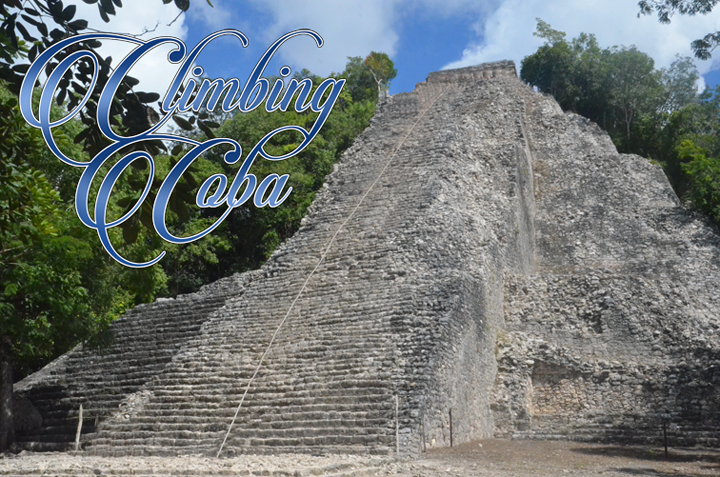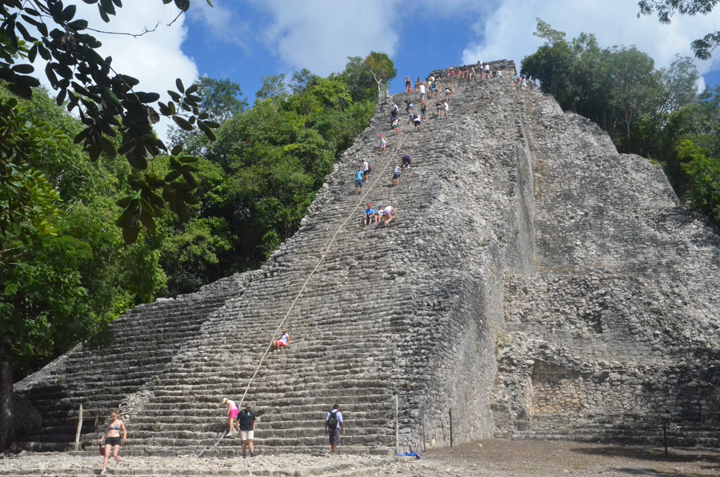Adventures in Mexico - Climbing Coba
With my mural completed, it was time for
the one item on my tourist "to do" list. Tours in and around Playa del
Carmen were priced about what you might expect in a tourist
destination. In case there is any doubt, they were very
expensive. Everything was around one hundred dollars.
Okay, the tour to Tulum and Coba was eighty-five dollars. I was
fairly sure I could do the trip for a fraction of that cost. Of
course, with a guide, you get a lot more information and, if you are
lucky, some personal attention. I decided that I could go to Coba
on my own, research all I needed to know, save a bundle of pesos, and
have a Mexican experience.
Coba is one of the many Maya archaeological sites in the Yucatán Peninsula. It doesn't have the fame or name of Chichen Itza and it didn't make international news like Tulum where Justin Bieber decided he could hike where nobody (no matter how entitled) should go. Coba is located somewhere between these two destinations, and a little less visited.
Archaeological evidence indicates that Coba was first inhabited between 50 BC and 100 AD. At its peak of civilization, there were about 50,000 inhabitants. Between 200 to 600 AD, Coba was one of the dominant forces in the northern Yucatán with control of agricultural regions, roadway systems, and water resources. And then, Chichen Itza came upon the scene.
My bus took me to the town of Coba, not the archaeological site. But, it was not hard to figure out what to do. Follow the line of backpacker type tourists heading forward on the main road out of town. Yes, there were several available taxis, but that was not a part of my plan. I had walked a lot in Mexico, and I was very pleased about my endurance.
The parking lot at the archaeological site had five tour buses and around fifty cars. Okay, the place was busier than I hoped for on a weekday. It was certainly better than any weekend crowd. And, I was soon to discover that Coba was huge and that amount of people easily spread out.
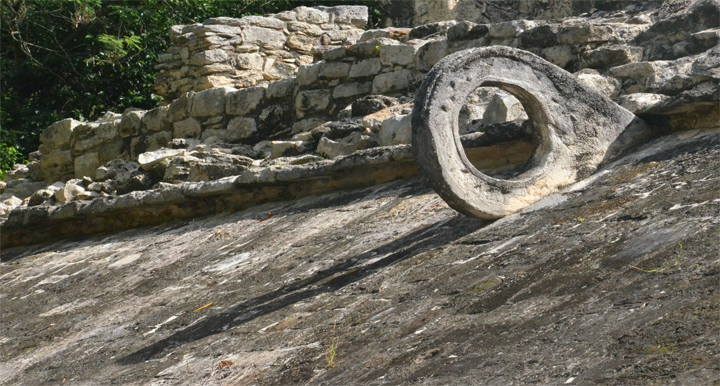
Close to the entrance were two Maya ball parks. I didn't have to
read any signs. I don't think there were any anyway. I knew what
they were when I saw the stone rings on either side of the court.
Teams of one to four athletes used their hips instead of their hands as
they tried to get a ten-pound rubber ball through the hoops.
Scoring was difficult. The game usually ended when one team scored
or if the ball touched the ground. This ball game wasn’t like any
sports today. It was a solemn experience. And, if you lost,
there was a good chance you were also going to be sacrificed.
Of course, you were not allowed to climb those courts for the proper photographs. But, they really were not the reason people visited Coba. There was also a huge temple area, and that was the destination in Coba. And, it was obviously a bit of a hike. I gathered that when I saw all the bikes for rent and the tricycle taxi drivers for hire.
I opted to hoof it.
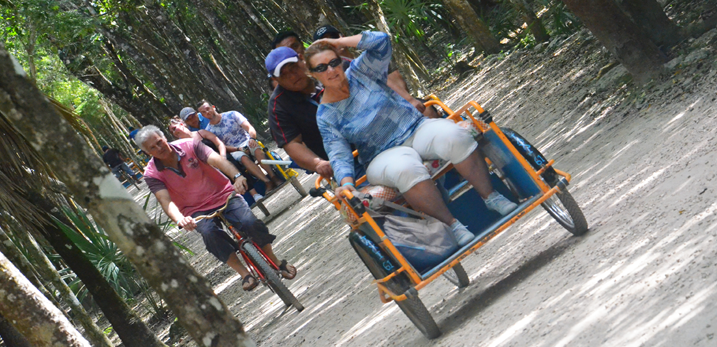
It was a peaceful walk along a winding path among the trees. Of course, you were not allowed to totally zone out amid the beauty. At any moment, a flurry of bicycles could take over the path. You had to remain alert.
The temple complex, called Nohoc-Mul, got its name for fairly obvious reasons if you speak Mayan. Not on your list of skills? Nohoc translates as "big" and mul means "mound". I told you it made sense. It is the tallest structure in the northern Yucatán, built around 780 A.D. And, unlike anything in Chichen Itza, Tulum, or the rest of Coba, you are allowed to go to the top of this big mound.
There was a hefty rope running top to bottom. Many people relied on it. Very fortunately, and with a little bit of pride, I didn't need the rope. I decided to take the mound twenty-five steps at a time. On the first few rounds, I didn't really need to stop and rest. I did so anyway. And, I had to rest on the later rounds. I heard somebody say there were 128 steps. I never counted them. I was surprised how easily I got to the top.
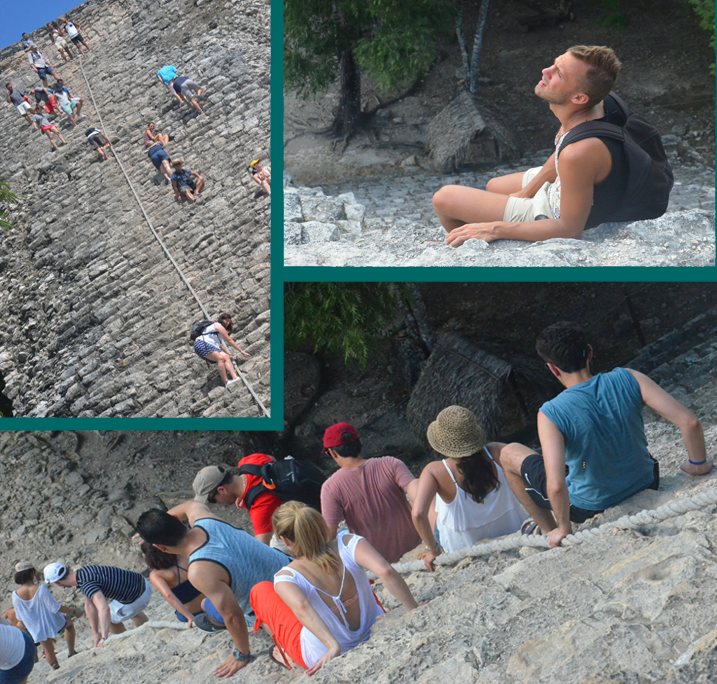
Visitors numbered from six to twenty-six while I was atop the pyramid. I would have loved even thirty seconds to myself. That never happened.
I saw so many people struggling to descend. Many people sat on the steps and eased themselves down, one sitting at a time, polishing those stones with their rear ends. Perhaps several of the stone steps had also been polished smooth from centuries of footsteps. Either way, the polishing continues. Much to my relief, I didn't find it difficult. I had to be careful because a few of those polished stones were slippery, but it was not any challenge.
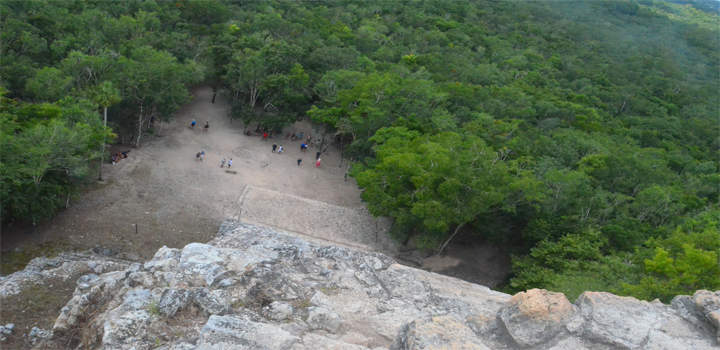
Coba is one of the many Maya archaeological sites in the Yucatán Peninsula. It doesn't have the fame or name of Chichen Itza and it didn't make international news like Tulum where Justin Bieber decided he could hike where nobody (no matter how entitled) should go. Coba is located somewhere between these two destinations, and a little less visited.
Archaeological evidence indicates that Coba was first inhabited between 50 BC and 100 AD. At its peak of civilization, there were about 50,000 inhabitants. Between 200 to 600 AD, Coba was one of the dominant forces in the northern Yucatán with control of agricultural regions, roadway systems, and water resources. And then, Chichen Itza came upon the scene.
My bus took me to the town of Coba, not the archaeological site. But, it was not hard to figure out what to do. Follow the line of backpacker type tourists heading forward on the main road out of town. Yes, there were several available taxis, but that was not a part of my plan. I had walked a lot in Mexico, and I was very pleased about my endurance.
The parking lot at the archaeological site had five tour buses and around fifty cars. Okay, the place was busier than I hoped for on a weekday. It was certainly better than any weekend crowd. And, I was soon to discover that Coba was huge and that amount of people easily spread out.

Of course, you were not allowed to climb those courts for the proper photographs. But, they really were not the reason people visited Coba. There was also a huge temple area, and that was the destination in Coba. And, it was obviously a bit of a hike. I gathered that when I saw all the bikes for rent and the tricycle taxi drivers for hire.
I opted to hoof it.

It was a peaceful walk along a winding path among the trees. Of course, you were not allowed to totally zone out amid the beauty. At any moment, a flurry of bicycles could take over the path. You had to remain alert.
The temple complex, called Nohoc-Mul, got its name for fairly obvious reasons if you speak Mayan. Not on your list of skills? Nohoc translates as "big" and mul means "mound". I told you it made sense. It is the tallest structure in the northern Yucatán, built around 780 A.D. And, unlike anything in Chichen Itza, Tulum, or the rest of Coba, you are allowed to go to the top of this big mound.
There was a hefty rope running top to bottom. Many people relied on it. Very fortunately, and with a little bit of pride, I didn't need the rope. I decided to take the mound twenty-five steps at a time. On the first few rounds, I didn't really need to stop and rest. I did so anyway. And, I had to rest on the later rounds. I heard somebody say there were 128 steps. I never counted them. I was surprised how easily I got to the top.

Visitors numbered from six to twenty-six while I was atop the pyramid. I would have loved even thirty seconds to myself. That never happened.
I saw so many people struggling to descend. Many people sat on the steps and eased themselves down, one sitting at a time, polishing those stones with their rear ends. Perhaps several of the stone steps had also been polished smooth from centuries of footsteps. Either way, the polishing continues. Much to my relief, I didn't find it difficult. I had to be careful because a few of those polished stones were slippery, but it was not any challenge.

The view
from atop the big mound
None of this success stopped me from
taking a tricycle taxi back to the entrance. I wanted the
experience and I saved so very much money by not taking a tour. It
was an easy splurge.
I had lots of time before my scheduled bus departure back to Playa. I headed back towards the town of Coba. But, I made a delicious detour along the way. A little cafe offered traditional Maya cuisine. I had no idea what that included, but I was going to learn. And, I think it was meant to be. As soon as I sat down, a rain storm popped up out of nowhere. I was seated, dry, and ready to discover Poc Chuc de Cerdo.
Again, if you spoke Mayan, you would instantly know what Poc Chuc is all about. Poc (or póok) means roasted or grilled and chuc (or chúuk) means over wood coals. It’s a traditional Maya dish of meat prepared in a citrus marinade and then grilled to perfection. "Cerdo" was pork, but another options can use chicken or fish. The English portion of the menu described the dish as pork fillet with grilled achiote Mayan sauce, served with beans, rice, vegetables, and handmade tortillas.
I had lots of time before my scheduled bus departure back to Playa. I headed back towards the town of Coba. But, I made a delicious detour along the way. A little cafe offered traditional Maya cuisine. I had no idea what that included, but I was going to learn. And, I think it was meant to be. As soon as I sat down, a rain storm popped up out of nowhere. I was seated, dry, and ready to discover Poc Chuc de Cerdo.
Again, if you spoke Mayan, you would instantly know what Poc Chuc is all about. Poc (or póok) means roasted or grilled and chuc (or chúuk) means over wood coals. It’s a traditional Maya dish of meat prepared in a citrus marinade and then grilled to perfection. "Cerdo" was pork, but another options can use chicken or fish. The English portion of the menu described the dish as pork fillet with grilled achiote Mayan sauce, served with beans, rice, vegetables, and handmade tortillas.
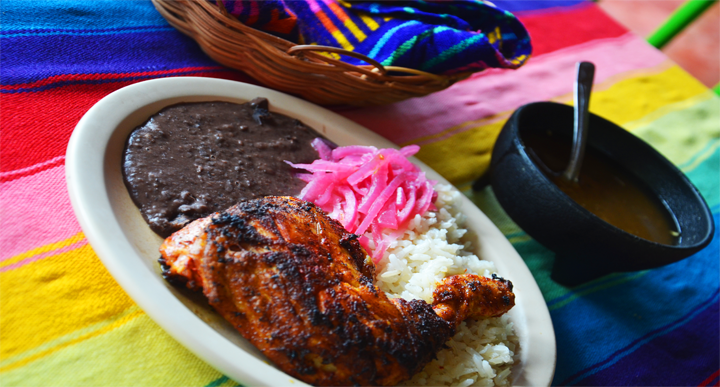
Assuming like me, you’ve never heard of achiote, I had to ask. I was shown some dried leaves and explained that they were used in cooking to add color to the dish. Achiote is also used in commercial products to add yellow and orange coloring to butter, cheese, cakes, sausage, and even popcorn. However, I found the original use much more interesting. Indigenous people used to use achiote for body paint and lipstick.
The vegetables included grilled onions sautéed with coriander over the pork, sliced cucumbers, and tomatoes. My meal had rice and frijoles. Every authentic meal in Mexico has rice and beans. But, I suspected that no Maya chef ever really used rice. So, I researched. There was no rice. The three staples, called the three sisters, were squash, corn, and beans. Perhaps she was a half-sister, because the fourth staple – never called a sister – was chili peppers. My meal also included three varieties of salsa. One was green fire. I don’t know if it is the one I researched called “dog snout salsa” but it very well could be. It gets that name because it makes your nose run. Whatever I had certainly did that to my nose.
As far as "handmade" tortillas go, I think I was more of an expert than the usual gringo who showed up at this restaurant's doorstep. I'd witnessed tortillas mass-produced by machines that automatically spit them out until the batch of dough was finished. I'd also witnessed the individual tortilla press at Mama Javier's restaurant. I expected "handmade" to mean there were actual hand prints on the finished product. I was served perfectly made, flat tortillas just like Mama Javier made. So, they may not have been as "handmade" as I wanted, but that didn't stop me from eating every single one of them.
The indigenous people of Mexico were the first to realize the joys of chocolate, savored by the Olmecs, Mayas, and Aztecs alike. Evidence suggests that it was consumed as early as 2600 years ago. However, sugar didn’t exist in the Maya world. The word chocolate comes from the Maya word “xocolati” which means “bitter water”. Their hot chocolate was a mixture of crushed cocoa beans, water, and hot chili peppers. Yep, that adds a whole new meaning to “hot chocolate”.
Well, there is sugar in Mexico today. But, my traditional Maya meal didn’t have any dessert, chocolate, or sugar. It really didn’t matter. This meal was an unexpected treat. When I travel, I have a short list of things to do. Anything additional is considered “extra dessert”. My “to do” item was to climb Coba. So, enjoying this unexpected and unplanned meal was enough of a “dessert” for me.
